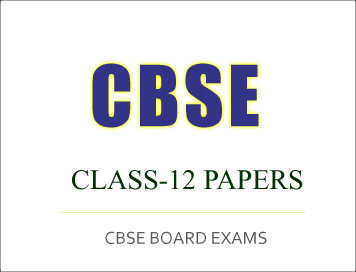CBSE Class-12 Exam 2017 : All India Scheme Question Paper, Legal Studies
Disclaimer: This website is NOT associated with CBSE, for official website of CBSE visit - www.cbse.gov.in
CBSE Class-12 Exam 2017 : All India Scheme
Question Paper, Legal Studies
CBSE Class-12 Exam 2017 : Legal Studies
- कृपया जाँच कर लें कि इस प्रश्न-पत्र में मुद्रित पृष्ठ 16 हैं ।
- प्रश्न-पत्र में दाहिने हाथ की ओर दिए गए कोड नम्बर को छात्र उत्तर-पुस्तिका के मुख-पृष्ठ पर लिखें ।
- कृपया जाँच कर लें कि इस प्रश्न-पत्र में 30 प्रश्न हैं ।
- कृपया प्रश्न का उत्तर लिखना शुरू करने से पहले, प्रश्न का क्रमांक अवश्य लिखें ।
- इस प्रश्न-पत्र को प‹ढने के लिए १५ मिनट का समय दिया गया है । प्रश्न-पत्र का वितरण पूर्वाङ्घ में १०.१५ बजे किया जाएगा । १०.१५ बजे से १०.३० बजे तक छात्र केवल प्रश्न-पत्र को प‹ढेंगे और इस अवधि के दौरान वे उत्तर-पुस्तिका पर कोई उत्तर नहीं लिखेंगे ।
- Please check that this question paper contains 16 printed pages.
- Code number given on the right hand side of the question paper should be written on the title page of the answer-book by the candidate.
- Please check that this question paper contains 30 questions.
- Please write down the Serial Number of the question before attempting it.
- 15 minute time has been allotted to read this question paper. The question paper will be distributed at 10.15 a.m. From 10.15 a.m. to 10.30 a.m., the students will read the question paper only and will not write any answer on the answer-book during this period.
विधिक अध्ययन
LEGAL STUDIES
निर्धारित समय : ३ घण्टे, अधिकतम अंक : १००
Time allowed : 3 hours, Maximum Marks : 100
सामान्य निर्देश :
(1) इस प्रश्न-पत्र में कुल ३० प्रश्न हैं ।
(2) सभी प्रश्नों के उत्तर देना अनिवार्य हैं ।
(3) प्रश्न संख्या १ से ८ बहुविकल्पीय प्रश्न हैं और प्रत्येक के लिए १ अंक निर्धारित है ।
(4) प्रश्न संख्या ९ से १४ लघु उत्तरीय प्रश्न हैं और प्रत्येक के लिए २ अंक निर्धारित हैं । इनमें से प्रत्येक का उत्तर ५० शब्दों से अधिक न हो ।
(5) प्रश्न संख्या १५ से २० लघु उत्तरीय प्रश्न हैं और प्रत्येक के लिए ४ अंक निर्धारित हैं । इनमें से प्रत्येक का उत्तर १०० शब्दों से अधिक न हो ।
(6) प्रश्न संख्या २१ से २४ दीर्घ उत्तरीय प्रश्न हैं और प्रत्येक के लिए ५ अंक निर्धारित हैं । इनमें से प्रत्येक का उत्तर १५० शब्दों से अधिक न हो
(7) प्रश्न संख्या २५ से ३० दीर्घ उत्तरीय प्रश्न हैं और प्रत्येक के लिए ६ अंक निर्धारित हैं । इनमें से प्रत्येक का उत्तर २०० शब्दों से अधिक न हो ।
General Instructions :
(i) There are 30 questions in all.
(ii) All the questions are compulsory.
(iii) Questions number 1 to 8 are multiple choice questions carrying 1 mark each.
(iv) Questions number 9 to 14 are short answer questions carrying 2 marks each. Answer to each of these should not exceed 50 words.
(v) Questions number 15 to 20 are short answer questions carrying 4 marks each. Answer to each of these should not exceed 100 words.
(vi) Questions number 21 to 24 are long answer questions carrying 5 marks each. Answer to each of these should not exceed 150 words.
(vii) Questions number 25 to 30 are long answer questions carrying 6 marks each. Answer to each of these should not exceed 200 words.
१. वर्ष १९५० में भारतीय संविधान ने एक प्रधान न्यायाधीश तथा ______________ न्यायाधीशों के उच्चतम न्यायालय पर विचार प्रस्तुत किया । १
(क) आठ
(ख) सात
(ग) बारह
(घ) चौबीस
In the year 1950, the Constitution of India envisaged a Supreme Court with one Chief Justice and ____________ judges.
(a) eight
(b) seven
(c) twelve
(d) twenty-four
२. आद्विक ने अपने मित्र संदीप को rs ५०,००० में अपनी बाइक बेची जबकि उस बाइक का बाजार मूल्य rs ७५,००० है । १
उपर्युक्त अनुबंध
(क) प्रवर्तनीय नहीं है क्योंकि आद्विक बाμजार मूल्य से कम मूल्य पर अपनी बाइक नहीं बेच सकता ।
(ख) प्रवर्तनीय है क्योंकि मूल्य का पर्याप्त होना नहीं, वास्तविक होना आवश्यक है ।
(ग) प्रवर्तनीय नहीं है क्योंकि मूल्य गैर-कानूनी है ।
(घ) प्रवर्तनीय है क्योंकि मूल्य पर्याप्त और तर्कसंगत है जबकि बाइक एकदम नई नहीं है ।
Aadwik sells his bike for a consideration of rs 50,000 to his friend
Sandeep, whereas the market price of the said bike is rs 75,000.
The above agreement is
(a) not enforceable as Aadwik cannot sell his bike below the market price.
(b) enforceable as the consideration need not be adequate, but should be real.
(c) not enforceable as it is an unlawful consideration.
(d) enforceable as the consideration is adequate and reasonable as the bike is not brand new.
